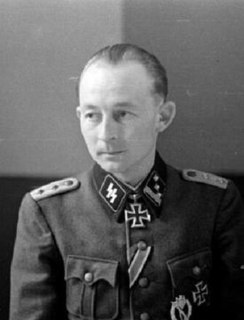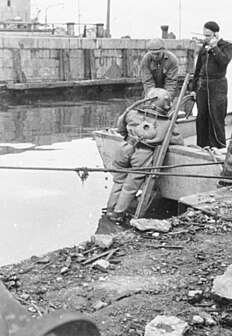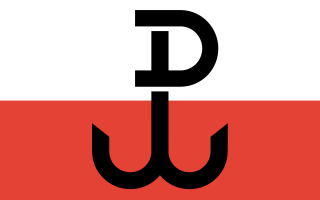
The Volkssturm was a national militia established by Nazi Germany during the last months of World War II. It was not set up by the German Army, the ground component of the combined German Wehrmacht armed forces, but by the Nazi Party on the orders of Adolf Hitler and its existence was only officially announced on 16 October 1944. It was staffed by conscripting males between the ages of 16 and 60 years who were not already serving in some military unit. The Volkssturm comprised one of the final components of the total war promulgated by Propaganda Minister Joseph Goebbels, part of a Nazi endeavor to overcome their enemies' military strength through force of will.

National Guard is the name used by a wide variety of current and historical uniformed organizations in different countries. The original National Guard was formed during the French Revolution around a cadre of defectors from the French Guards.

This is a Timeline of the United Kingdom home front during World War II covering Britain 1939–45. For a brief narrative see United Kingdom home front during World War II, as well as History of Scotland#Second World War 1939-45 and History of Northern Ireland#Second World War. For the military story see Military history of the United Kingdom during World War II for foreign affairs, Diplomatic history of World War II,. For the government see Timeline of the first premiership of Winston Churchill. For a narrative history and bibliography of the home front see United Kingdom home front during World War II.
An auxiliary force is an organized group supplementing but not directly incorporated in a regular military or police entity. It may comprise either civilian volunteers undertaking support functions or additional personnel directly performing military or police duties, usually on a part-time basis.

Hans-Valentin Hube was a general in the Wehrmacht of Nazi Germany during World War II. He commanded several panzer divisions during the invasions of Poland, France and the Soviet Union. He was a recipient of the Knight's Cross of the Iron Cross with Oak Leaves, Swords and Diamonds, Nazi Germany's highest military decoration. Hube died in an air crash on 21 April 1944.

Georg Keppler was a high-ranking Waffen-SS commander during World War II. He commanded the SS Division Das Reich, SS Division Totenkopf, I SS Panzer Corps, III SS Panzer Corps and the XVIII SS Army Corps.

SS Heimwehr "Danzig" was an SS unit established in the Free City of Danzig before the Second World War. It fought with the German Army against the Polish Army during the invasion of Poland, and some of its members committed a massacre of Polish civilians. After this it became part of the 3rd SS Totenkopf Division and ceased to exist as an independent unit.

Paul Maitla was an Estonian commander in the German Waffen-SS during World War II. He is one of the four Estonians who received the Knight's Cross of the Iron Cross of Nazi Germany. He received his award for leading the recapture of the central hill of the Sinimäed during the Battle of Tannenberg Line, effectively breaking the Soviet offensive in that sector.

The Free Belgian forces were soldiers from Belgium and its colonies who fought as part of the Allied armies during World War II, after the official Belgian surrender to Nazi Germany. It is distinct from the Belgian Resistance which existed in German-occupied Belgium.

Wolfgang Falck was a German officer during World War II. He was one of the key organisers of the German night fighter defences of the Luftwaffe.

Harald Riipalu was an Estonian commander in the German Wehrmacht and the Waffen-SS during World War II. He was a recipient of the Knight's Cross of the Iron Cross of Nazi Germany.

The 361st Fighter Group was a World War II United States Army Air Forces combat organization. It served primarily in the European Theatre of World War II.

Alfred Keller was a general in the Luftwaffe of Nazi Germany during the Second World War who commanded the Luftflotte 1. His career in the Imperial German Armed Forces began in 1897; he became one of the most decorated generals of the former Luftwaffe.

The Omakaitse was a militia organisation in Estonia. It was founded in 1917 following the Russian Revolution. On the eve of the Occupation of Estonia by the German Empire the Omakaitse units took over major towns in the country allowing the Salvation Committee of the Estonian Provincial Assembly to proclaim the independence of Estonia. After the German Occupation the Omakaitse became outlawed.

Otto Dessloch was a German Luftwaffe general during World War II and recipient of the Knight's Cross of the Iron Cross with Oak Leaves of Nazi Germany.
Johannes Soodla was an Estonian military officer during World War I, Estonian War of Independence and World War II, serving in Kuperjanov's Partisan Battalion and the 20th Waffen Grenadier Division of the SS. In 1944 he was promoted to Brigadeführer, which was the highest rank ascribed to any Estonian officer in the German army during World War II.
The Ustashe Militia was the party army of the Ustashe, established by the fascist regime of Ante Pavelić in the Axis puppet state the Independent State of Croatia (NDH) in Yugoslavia during World War II.
The following are articles about the topic of France during World War II:




















